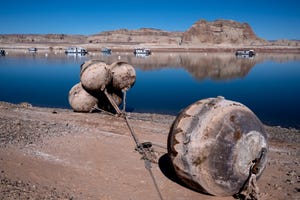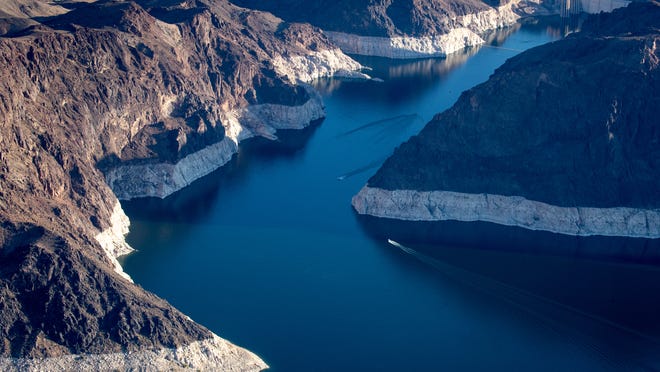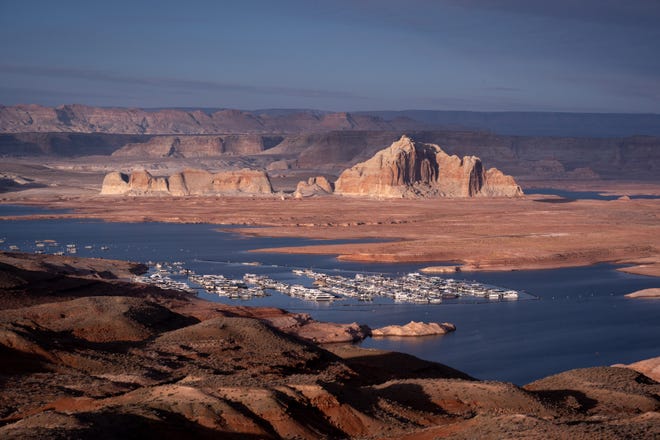The federal government must rapidly prepare plans to redesign Glen Canyon Dam’s plumbing to keep the Colorado River flowing through the Grand Canyon as the water levels behind the dam continue to fall, a coalition of environmental groups warned on Wednesday.
Lake Powell is just a quarter full, its surface now at 3,536 feet above sea level — 46 feet from the minimum level to produce hydropower — and falling after the early summer gush of snowmelt from the Rocky Mountains. Two more dry winters could push the reservoir past that point, according to forecasters, and ultimately dam managers may have to open bypass tunnels more than 100 feet deeper just to keep the river flowing.
If it comes to that, the river advocates and their new analysis caution, those tunnels will prove insufficient to release as much water as the Southwest counts on to pass through the Grand Canyon and restock Lake Mead each year.
“This system needs flexibility and it needs it now,” said Eric Balken, whose Glen Canyon Institute partnered with the Utah Rivers Council and the Great Basin Water Network on a new report urging action.

Lake Powell’s elevation has dropped more than 160 feet since it was essentially full at the turn of this century, and the pace has quickened in recent years. Dropping below what the outlets were designed to handle would jeopardize delivery of the water needed to irrigate farms and fully supply cities from Phoenix and Las Vegas to Los Angeles and Tijuana.
The groups’ quest is to persuade the US Bureau of Reclamation, which manages the dam, to study how to keep the river flowing if, as their analysis suggests, climate change and overuse push the system to a breaking point in coming years. Their preferred alternatives are to either expand the capacity of the bypass tunnels or build new tunnels at the dam’s base to allow the river to flow even if Lake Powell empties.
Agency looks for ways to preserve power production

On their first premise — the need to act to prevent the loss of hydropower — they’ll find agreement from many corners. The Bureau of Reclamation, the state of Arizona and the group representing the dam’s hydropower customers all say the region’s two decades of drought present an imminent threat to normal operations at Glen Canyon.
“Given the current uncertainties facing the Colorado River system, as well as the engineering uncertainties involving moving water through the existing infrastructure of Glen Canyon Dam with historically low levels, it would be prudent to thoroughly investigate all reasonable options for making changes to the infrastructure of the dam that enhance its capacity to move large volumes of water safely,” said Arizona Water Resources Director Tom Buschatzke.
NASA images reveal:Lake Mead’s water supply reaches record-low levels
A Reclamation spokeswoman said the agency has committed $2 million to study options to both continue generating power and meet water supply commitments to Arizona, Nevada, California and northwestern Mexico. One such idea that has long been discussed is the option of fitting hydropower turbines lower, in the bypass tunnels.
The idea of building new outlets around the dam’s base, essentially allowing the government to drain the reservoir at least temporarily if and when water managers decided that’s best, is more controversial.
“It gets you to the same point (environmentalists) have always been at, and that’s drain out Powell and fill Mead,” said Leslie James, executive director of the Colorado River Energy Distributors Association.
What is the future for both ladies?
The Glen Canyon Institute for years advocated a “Fill Mead First” proposal that would push Powell’s stored water downstream to an equally depleted Lake Mead, restoring treasured natural and recreational assets flooded behind Glen Canyon Dam.
That’s a prospect that ends hydropower production for customers who live around the West, including numerous tribes, so James opposes it. But she welcomes a Reclamation study of other options.
“I’m glad they’re doing it,” she said. “They’re the ones that know the dam inside and out.”

Fill Mead First is an idea whose time has passed, Balken said, if only because draining all the water from Powell at this point would not, in fact, be nearly enough to fill the larger reservoir downstream. Instead, he said, a river-level bypass system would allow the government to continue moving water downstream regardless of how low Lake Powell falls.
As currently designed, the dam would stop releasing water if the reservoir falls below the existing bypasses, effectively drying up the Grand Canyon and trapping nearly 2 million acre-feet of water behind the dam, nearly two-thirds of what Arizona would normally take from the river in a year.
Founded in Lake Mead:World War II-era boat emerges from lake in Arizona
But the Southwest would suffer long before the river actually stopped flowing, Balken and colleagues say, because the reservoir’s declining elevation would reduce pressure that causes water to gush from either the power intakes or the bypass tunnels. For this part of their analysis, they relied on a white paper produced by river scientist Jack Schmidt and colleagues at Utah State University.
Schmidt, a former chief of the government’s Grand Canyon Monitoring and Research Center, published a paper in 2016 that included a quantification of the amount of water that the dam could move in a year at various elevations.
At elevation 3,430 feet, the volume that the dam could push downstream would drop below the 7.5 million acre-feet that the Colorado River Compact requires upstream states to supply to the states below Glen Canyon, not to mention the 1.5 million acre-feet in Mexico’s treaty allocation.
At 3,400 feet, still 26 feet above where the bypass tubes start to go dry, the dam could deliver less than half of the Southwestern states’ normal entitlement.
If drought worsens, the risks will grow
That entitlement already took a hit due to the shortage in Lake Mead this year. It was expected to shrink further next year, even before Reclamation’s commissioner announced in June that the states throughout the river basin need a plan to forego up to another 4 million acre-feet, which is about a third of what the river has produced most years during the drought.
The rapidly shifting mandates from the Bureau of Reclamation demonstrate the increasingly dire outlook, said Zach Frankel, executive director of the Utah Rivers Council. States were given just two months to plan dramatic cuts before the government sets 2023 shortage levels later this month.
“For an agency that normally moves at a glacial pace,” he said, “that’s pretty remarkable.”
Fast action is imperative, according to the report by Frankel and colleagues. In their analysis, a continuation of the weather and resulting flows that the Colorado experienced from 2017 to 2021 would push Lake Powell too low to make its obliged water deliveries by 2027.
They studied that timeframe, they said, because it fairly represents the 21st century’s reduction in flows, about 20% below last century’s. If, however, the coming years look more like the exceptionally dry stretch that occurred from 2000 to 2004, they projected the dam could lose its ability to move any water as soon as 2025.
Brandon Loomis covers environmental and climate issues for The Arizona Republic and azcentral.com. Reach him at [email protected] or follow on Twitter @brandonloomis.
Environmental coverage on azcentral.com and in The Arizona Republic is supported by a grant from the Nina Mason Pulliam Charitable Trust. Follow The Republic environmental reporting team at environment.azcentral.com and @azcenvironment on Facebook, Twitter and Instagram.
Support local journalism. Subscribe to azcentral.com today.